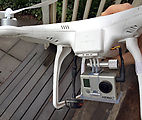Summary
My current toy for taking aerial photos is a DJI Phantom quadcopter (RC helicopter with four propellers) carrying a GoPro Hero2 camera [now upgraded to GoPro Hero3+ Black ], and retrofitted to transmit a video signal to FatShark Attitude SD goggles I wear while flying for the first-person-view ("FPV") experience .
Details
Compared with the Draganfly V Ti quadcopter I last experimented with, the DJI Phantom is simply amazing. While I always had to be actively moving and responding to keep the old Draganfly from flying out of control, the DJI Phantom — with its GPS and better gyro circuits — will simply hover in place if I let go of the controls! Even better, it will automatically fly home and land if it loses signal! Flying my old Draganfly was more like balancing a broomstick by the end of its handle — it took lots of practice to learn, and was never easy. After one horrible crash, I never again dared to fly my Draganfly up for high-altitude photos lest I lose the ability to see which way it was facing.
Range is about 1 mile horizontally.
Strength — the DJI Phantom is amazingly strong. Hard landings and crashes usually cause no damage at all. Again, I remember my old Draganfly quadcopter that required me to bust out the glue and do some serious surgery every time I performed anything other than a soft landing.
If I were serious about filming video, I'd also add a gimbal so the video would always stay level as I bank the quadcopter in turns. I'd also make sure to improve the camera mount damping, as the vibrations from the DJI Phantom's motors cause a wiggling "jello" effect in recorded video. I mostly take still images, so it doesn't matter too much to me.



